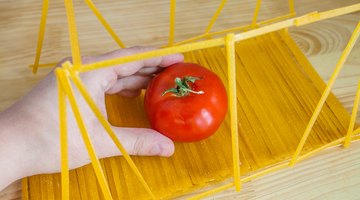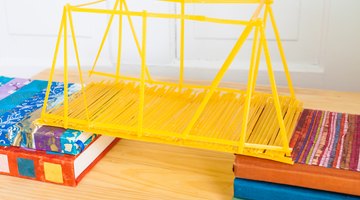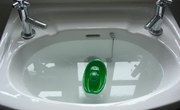Building a spaghetti bridge applies the principles of science and math to a fun activity. Creating this type of bridge requires the use of design, planning and construction. Even though it is possible to build a spaghetti bridge without using science and math, if you want to build one that’s strong enough to support a heavy load -- it’s important to understand what materials you’re using and why, how to best construct the structure of the spaghetti bridge -- and to understand what the ultimate goal is. Students often build a pasta or spaghetti bridge for a contest, although students may also do this in school or at home on their own.
The Materials
The spaghetti bridge is built out of store-bought spaghetti or linguini. Don't use home-made spaghetti. White glue and model airplane glue also are not ideal, as white glue takes too long to dry, and model airplane glue is too flexible. For building a spaghetti bridge, epoxy glue is the best solution for gluing the spaghetti bridge together, even though it requires careful mixing. You can cut, bend or break the spaghetti and you can also glue two pieces of spaghetti together to create a stronger strand. For contests, gluing more than two pieces of spaghetti together isn’t allowed, as this is called "double bonding" as it creates an unfair advantage over other contestants. If you are making this for yourself or only for your class, you can double bond, if you wish.

Goals and Contest Rules
One goal of building a spaghetti bridge is so you will know how difficult it is to put theory into practice. Building a spaghetti bridge is a way to develop and test good construction techniques. If you're building the bridge for a contest -- regardless of the specific, unique rules for building your bridge --- the most important goal is to build a bridge that supports the heaviest load. One example of a set of rules for building your bridge is to specify that it must span 50 centimeters and weigh no more than 250 grams. Even though the specific length and weight of your spaghetti bridge varies depending on your instructor, you would place the load at the center of the span.

The Bridge's Design
Before constructing your bridge, make a full-size drawing that includes all components of the design. This not only ensures that the bridge’s pieces will fit together when you construct it, this also allows you to plan the most efficient way to design your bridge. Make the design simple and use inverted triangles to ensure the bridge is most stable. A triangle that has the apex on the top isn’t as stable as an inverted triangle. The bearing points are most efficient when they’re flat and smooth. The bridge can twist and break if the bearing point isn’t flat.

The Construction and Loading
Be careful how much hot glue you use, as hot glue has a tendency to cook and melt the spaghetti. Just use enough hot glue to hold the pieces together, but no more than that. The most efficient spaghetti connections are strong and flexible. If the connections are too rigid, the joints will add bending force to the spaghetti, which tends to break the spaghetti. When you have finished building the bridge, place the load gently in the bridge's middle. Do not place the load on the bridge and then take it off. This puts needless pressure on the joints and will lead to the bridge failing.

Related Articles
References
Writer Bio
Jake Shore is an award-winning Brooklyn-based playwright, published short story writer and professor at Wagner College. His short fiction has appeared in many publications including Litro Magazine, one of London's leading literary magazines. Shore earned his MFA in creative writing from Goddard College.











